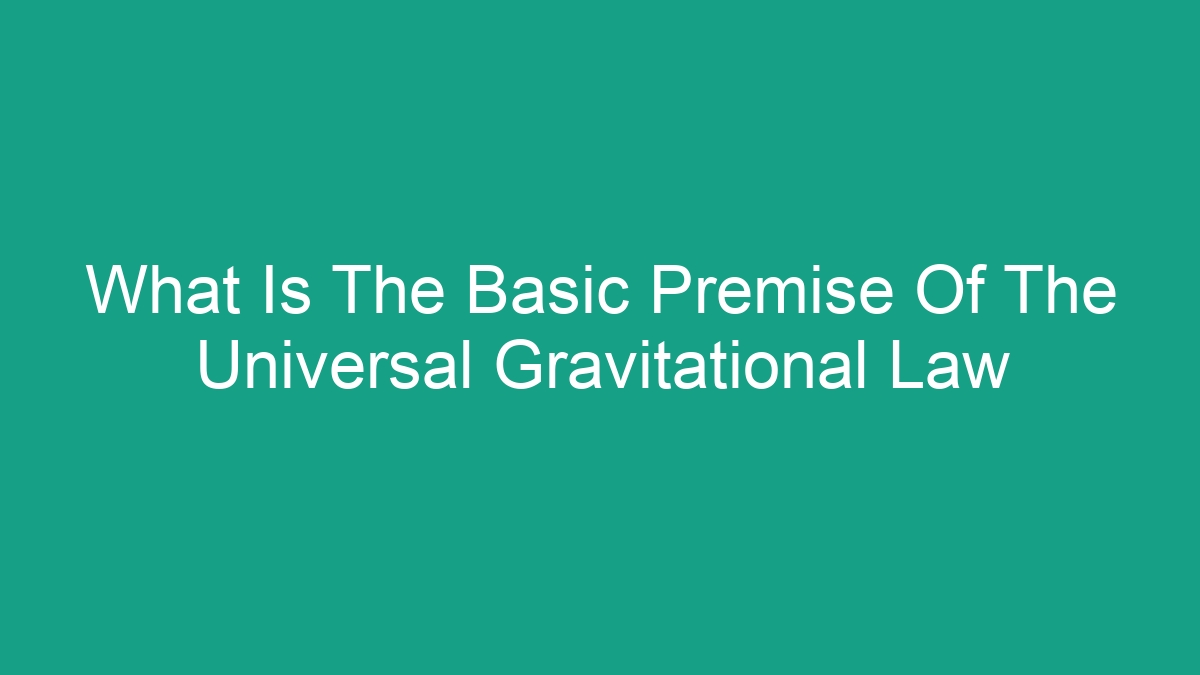
When Sir Isaac Newton formulated his law of universal gravitation, it revolutionized our understanding of the forces that govern the universe. The basic premise of the universal gravitational law is a fundamental concept in physics and astronomy, and understanding it is essential for understanding various phenomena, from the falling of an apple to the motion of planets in our solar system. In this article, we will explore the basic premise of the universal gravitational law and its implications for our understanding of the universe.
The Basic Premise of the Universal Gravitational Law
Newton’s law of universal gravitation states that every particle in the universe attracts every other particle with a force that is directly proportional to the product of their masses and inversely proportional to the square of the distance between their centers. Mathematically, it can be expressed as:
F = G * (m1 * m2) / r^2
Where:
- F is the force between the particles
- G is the gravitational constant
- m1 and m2 are the masses of the particles
- r is the distance between the centers of the particles
This law explains the force of gravity that exists between any two objects with mass. Whether it’s the gravitational attraction between the Earth and an apple falling from a tree, or the mutual attraction between the Sun and the planets in our solar system, Newton’s law of universal gravitation provides a framework for understanding these phenomena.
Implications of the Universal Gravitational Law
The basic premise of the universal gravitational law has several key implications that have shaped our understanding of the universe:
- Explanation of Planetary Motion: Newton’s law of gravitation explains the elliptical orbits of planets around the Sun. By understanding the force of gravity between the Sun and the planets, astronomers can calculate the trajectories and positions of celestial bodies with remarkable precision.
- Understanding Tides: The gravitational pull of the Moon and the Sun on the Earth’s oceans causes the tides. Newton’s law of universal gravitation provides the framework for understanding the nature and behavior of tides.
- Gravitational Lensing: This phenomenon occurs when the gravitational force of a massive object, such as a galaxy, bends the light from distant objects. This effect, predicted by Einstein’s theory of general relativity, is consistent with the basic premise of the universal gravitational law.
- Black Holes: The collapse of massive stars to form black holes is also consistent with the basic premise of the universal gravitational law. Black holes exert an incredibly strong gravitational pull, which is a consequence of their enormous mass and compact size.
Applications of the Universal Gravitational Law
Aside from its implications for our understanding of the cosmos, the universal gravitational law also has practical applications in various fields:
- Astrodynamics: Engineers and scientists use the principles of gravitational attraction to calculate the trajectories of spacecraft, satellites, and other objects in space. Understanding the force of gravity is crucial for planning and executing space missions.
- Geophysics: The study of the Earth’s gravitational field provides valuable information about its internal structure and composition. Geophysicists use gravitational measurements to map the density distribution of rocks and minerals beneath the Earth’s surface.
- Gravitational Wave Astronomy: The detection of gravitational waves, ripples in the fabric of spacetime, has opened a new window into the universe. These waves, predicted by Einstein’s theory of general relativity, are a direct consequence of the basic premise of the universal gravitational law.
Challenges to the Universal Gravitational Law
While Newton’s law of universal gravitation has been incredibly successful in describing and predicting the behavior of celestial bodies on human scales, it faces challenges when applied to extreme conditions such as the behavior of stars in galaxies and the dynamics of the universe on the largest scales. Some of the challenges to the universal gravitational law include:
- Dark Matter: The observed motions of stars within galaxies cannot be fully explained by the gravitational pull of visible matter alone. This discrepancy has led scientists to propose the existence of dark matter, a mysterious form of matter that does not emit, absorb, or reflect light, but exerts a gravitational influence.
- Dark Energy: The accelerated expansion of the universe is another puzzle that challenges the predictions of the universal gravitational law. To account for this acceleration, scientists have proposed the existence of dark energy, a mysterious force that counteracts the attractive force of gravity on cosmological scales.
- Quantum Gravity: At the smallest scales, the principles of quantum mechanics and general relativity are in tension. The quest for a theory of quantum gravity, which unifies these two pillars of modern physics, is a major challenge in contemporary theoretical physics.
Conclusion
The basic premise of the universal gravitational law, as formulated by Sir Isaac Newton, has profoundly shaped our understanding of the forces that govern the universe. From the motion of planets to the behavior of light in the presence of massive objects, the implications of this fundamental law are vast and far-reaching. While it has provided a robust framework for understanding many phenomena, the challenges it faces on the largest and smallest scales are ongoing areas of research and exploration. As our understanding of the cosmos continues to evolve, the universal gravitational law remains a cornerstone of modern physics and astronomy.



